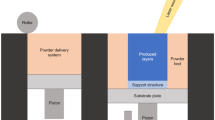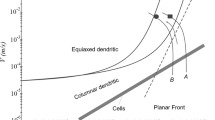Abstract
At the present time, the advantages of powder metallurgy acquire new emphasis due to the preparation of materials in a highly dispersed state. When coarse powders are replaced in a technological process by highly dispersed powders, the sintering temperature of pressed preforms can be decreased. which gives sintered articles with a more homogeneous and fine-grain structure. The broadened application range of highly dispersed powders (HDP) creates difficulties caused by the scarceness of data on their preparation, storage, shaping, and sintering. This is associated with methodological difficulties that appear in the investigation of the effect of the dispersity of the powder particles on the special features of compaction of preforms that have different physicochemical states and different chemical and phase compositions of the surface and the bulk of the particles. The present article concerns some special features of the morphology, structure, and physicochemical properties of HDP prepared under the conditions of low-temperature plasma.
Similar content being viewed by others
References
I. D. Morokhov, L. 1. Trusov, and S. P. Chizhik,Ultradispersed Metallic Media [in Russian], Atomizdat (1977).
R. U. Kalamazov, Yu. V. Tsvetkov, and A. A. Kal'kov,Highly Dispersed Tungsten and Molybdenum Powders [in Russian], Metallurgiya, Moscow (1988).
I. V. Frishberg, L. I. Kvator, B. P. Kuz'min, and S. V. Gribovskii,Gas-Phase Method for Producing Powders [in Russian], Nauka, Moscow (1978).
R. A. Andrievskii and A. A. Nuzhdin, “Amorphous and ultradispersed powders and materials based on them," in:Results in Science and Technology. Powder Metallurgy [in Russian], Vol. 2, Izd. VINITI, Moscow (1986), pp. 3 - 64.
Yu. V. Tsvetkov and S. A. Panfilov,Low-Temperature Plasma in Reduction Processes [in Russian], Nauka, Moscow (1980).
I. D. Morozov, V. I. Petinov, L. I. Trusov, and V. F. Petrunin. “Structure and properties of fine metallic particles,”Usp. Fiz. Nauk 133(4), 653 - 692 (1981).
Yu. L. Kruzhskii, G. V. Galevskii, and A. A. Kornilov, “Oxidation of ultradispersed powders of boron, vanadium, and chromium carbides,” Poroshlc Metallurg., No. 1, 47 – 50 (1983).
Yu. D. Tret'yakov,Chemistry of Nonstoichiometric Oxides [in Russian], Izd. MGU, Moscow (1974).
R. U. Kalamazov, Yu. V. Tsvetkov, N. K. Aleksandrova, et al., “Use of physical methods for studying the structure and shape of highly dispersed powders,”Fir. Khim. Obr. Mat, No. 3, 54 - 59 (1988).
I. D. Morokhov, L. I. Trusov, and V. N. Lapovok,Physical Phenomena in Ultradispersed Media [in Russian], Energoatomizdat, Moscow (1984).
L. I. Trusov, V. G. Gryaznov, V. I. Novikov, and I. P. Geleishvili, “Solid-phase transformations initiated by recrystallization,”Fiz. Tverd. Tela,27(9), 2726 - 2729 (1985).
S. Morrison,The Chemical Physics of Surfaces, Plenum, New York (1977).
A. Taskinen, “Dislocation density in carbonyl nickel during sintering,”J Mater. Sci.,15(9), 2253 - 22567 (1980).
P. S. Kislyi and M. A. Kuzenkova,Sintering of Refractory Compounds [in Russian], Naukova Dumka, Kiev (1980).
V. N. Lapovok, V. I. Novikov, S. V. Svirida, et al., Formation of nonequilibrium vacancies in recrystallization of an ultradispersed nickel powder,“Fi. Tverd. Tela,25(6), 1846 - 1848 (1983).
P. U. Arifov, R. U. Kalamazov, F. Li, and Yu. V. Tsvetkov, “Investigation of structural defects in ultradispersed powders of tungsten and molybdenum by the method of electron-positron annihilation,”Fiz. Khim. Obr. Mat., No. 3, 117 – 120 (1989).
Author information
Authors and Affiliations
Additional information
Translated from Metallovedenie i Termicheskaya Obrabotka Metallov, No. 3, pp. 17–21, March, 1996.
Rights and permissions
About this article
Cite this article
Kalamazov, R.U., Lem, I.N. Special features of mass transfer in sintering of highly dispersed metallic powders. Met Sci Heat Treat 38, 115–119 (1996). https://doi.org/10.1007/BF01401439
Issue Date:
DOI: https://doi.org/10.1007/BF01401439




